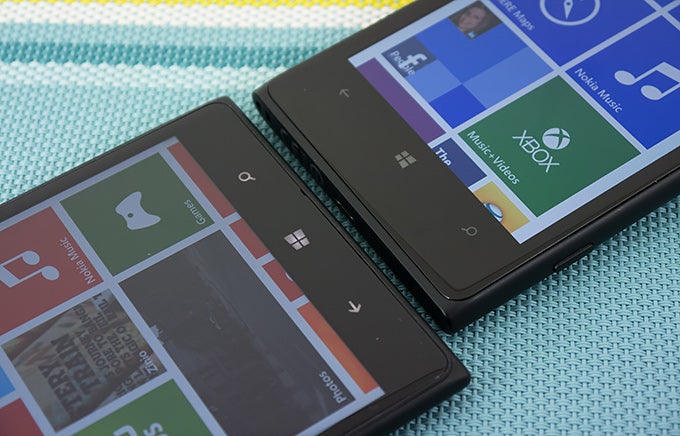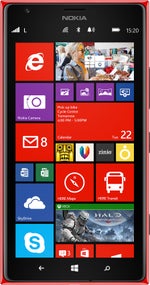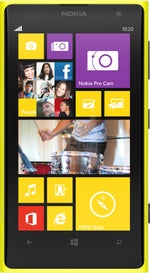Nokia Lumia 1520 vs Nokia Lumia 1020

Introduction
Boy it must be great being an AT&T customerif you’re the kind of person that takes fancy in Windows Phones, seeing that the carrier lays claim to two of the best ones out right now. Earlier in the fall, we were mesmerized by the carrier’s introduction of the Nokia Lumia 1020 – a device revered by many as being the best camera phone to launch this year. With its insanely large 41-megapixel PureView camera, it doesn’t seem like it’s going to be tested much in the camera snapping department any time soon.
Not to be outdone, the carrier was recently blessed with yet another fantastic offering that most people believe to be the best from the Finnish company this year – the phablet styled Nokia Lumia 1520. Brandishing a more modern hardware set, combined with a respectable 20-megapixel PureView camera, it’s no doubt the beefiest spec’d Windows Phone to date. Best of all, its $100 on-contract price from the onset wows many for its spectacular value. It’s the battle of the Lumias, so let’s find out how they duel against one another!
Design
Well, they’re distinctively Lumia devices, as they employ those unique design elements that have been a staple with the series for as long as we can remember. The only difference here is that the Lumia 1520 relies on a tapered design, which helps it to appear skinnier than what it says on paper. Furthermore, the Lumia 1020 features flat surface top and bottom edges – whereas it’s a little bit more rounded on the Lumia 1520. Overall, we find the design of the 1520 just a smidgen more appealing, despite the fact that they’re both available in different colors and have sturdy constructions.
What’s most apparent here is the size disparity, seeing that the Lumia 1520 is by far the beefier device between them. Due to its larger dimensions, it naturally has a wider figure, which doesn’t make it as comfortable to hold in the hand – more so when its pointy corners dig into our palms. Conversely, the 1020 is more form fitting in the hand, but the huge hump in the rear makes it top heavy and a bit awkward to hold in the hand when typing.
Taking a tour around the sides of both phones, they feature the same set of buttons and ports, which include their power buttons, volume controls, shutter keys, microUSB ports for charging/data connectivity, speaker grills, various mics, 3.5mm headset jacks, and SIM slots. However, the 1520 packs along an always-useful microSD card slot to increase its internal storage capacity.
Display
This one is a no-brainer, as one of them hosts the first 1080p resolution display to ever grace a Windows Phone. With its ginormous 6-inch 1080p IPS LCD display, not only does it impress us with its overall size, but it easily overshadows the smaller 4.5-inch 768 x 1280 AMOLED panel of the 1020. Yet again, we have to emphasize the 1080p resolution of the 1520’s display, mainly because it’s a first in the Windows Phone camp. This results in 368 ppi pixel density, compared to 334 ppi for the 1020's smaller display.
Seeing that they rely on two different display technologies, they have their particular strengths and weaknesses. Flaunting an IPS-LCD panel, the 1520’s display produces the more realistic colors tones, has the higher brightness output, and proves to have the superior outdoor visibility. On the other end, the 1020’s AMOLED panel catches our attention with its saturated color reproduction and wider viewing angles. However, it’s easily washed out under outdoor settings when the sun is present. At the end of the day, we can’t help but to give points to the 1520’s display.
Nokia Lumia 1520 360-Degrees View
Nokia Lumia 1020 360-Degrees View
Interface and Functionality
As we’ve come to know, Windows Phone is unique for having an experience that’s consistent between devices. Knowing that, it shouldn’t surprise people to know that the experience here is nearly identical with both devices. Still, it’s worth mentioning that there’s an added benefit to the 1520, since it’s currently packing along the GDR3 update with its Windows Phone 8 experience. Indeed, there are some minor new features in tow with the slight update, but for the most part, the core functions and features are the same on both handsets.
Obviously, the first noticeable difference in the experience is found with their start screens, where the 1520’s larger display is able to accommodate more live tiles into its package. Additionally, the GDR3 update brings forth features like being able to close down apps in the multi-tasking menu, custom notification tones, locking the screen rotation, and a useful Driving Mode that monitors various aspects of the phone as we’re driving. Beyond that, we wouldn’t say that there’s an astounding amount of advantage with the 1520’s updates – especially when they both can download the wealth of Nokia branded apps.
Honestly, we like typing with both smartphones, mainly because they have simple layouts, super responsive, and offer killer auto-correct features. Then again, some people will appreciate the more spacious layout in play with the 1520’s offering.
As for the rest, they provide us with the same level of personalization, organizer apps, and even take into consideration all of those hardcore productivity folks with their inclusion of Office. So what can we learn from this comparison? For starters, Nokia Windows Phones in general have an added incentive over other Windows Phones, but in this particular case, it’s only those enhancements with the GDR3 updates that prove to be the sole differentiator. Then again, the 1020 is bound to receive the update as well.
Processor and Memory
This certainly is a moot point well proven time-after-time! It seems as though, no matter what hardware is under the hood, Windows Phones are just expected to perform flawlessly. Looking at the hardware between them, it’s safe to assume that the 1520 is more future proof because it’s packing a more modern piece of silicon – a quad-core 2.2GHz Qualcomm Snapdragon 800 SoC coupled with 2GB of RAM and the Adreno 330 GPU. No doubt, it’s fast and nearly perfect with its performance, but to tell you the truth, the 1020’s dual-core 1.5GHz Qualcomm Snapdragon S4 Plus SoC with the Adreno 225 GPU and 2GB of RAM handles the same basic (and some complex) tasks with the same amount of performance.
With the AT&T variants of both handsets, the 1020 is packing along 32GB of storage, which is double over the 16GB of storage in the 1520. However, the 1520 is able to supplement its tally thanks to its available microSD slot.
Internet and Connectivity
When it comes down to it, the only thing separating the web browsing experience here is the larger display of the 1520 – enabling us to view more of page, without the need to pinch zoom. As for the rest, they’re identical with their offerings, which consist of fast 4G LTE speeds, fast page rendering, and very smooth navigational controls.
Being the newer smartphone, the 1520 is graced with the more modernized set of connectivity features too – such as Bluetooth 4.0 and dual-band 802.11 a/b/g/n Wi-Fi. In contrast, the 1020 features Bluetooth 3.0 and only your standard 802.11 a/b/g/n Wi-Fi radio. However, their commonalities include aGPS and NFC. Sorry folks, neither AT&T variants offer wireless charging.
Camera
Without question, they’re known highly for their photo snapping capabilities. Let’s first talk about what’s in their gear. For the 1520, it’s packing a 20-megapixel PureView camera, which features a dual-LED flash, Zeiss lens, and an aperture of f2.4. In comparison, the 1020 continues to stand out for its intimidating set of hardware – a monstrous 41-megapixel PureView camera featuring a combination LED/Xenon flash, f2.2 aperture, and the larger sensor size. Fortunately, they both tack on optical image stabilization, backside illuminated sensors, and 1080p video recording at 24, 25, and 30 FPS.It’s worth mentioning that their camera apps are identical to one another – an interface that’s rich with manual controls for white balance, shutter speed, ISO, exposure, and focus. Best of all, the layout of their camera UIs mimic those that grace most digital cameras nowadays. Even though it looks as though they’re lacking in the shooting mode departments, we can resort to either using the wealth of Nokia branded photo snapping apps out there, or the handful of “lenses.”
Peering meticulously over their shots, we’ll admit it’s a close race with their lower-resolution 5-megapixel samples, seeing that the only noticeable difference is the subtle saturation in the 1020’s shots. Once we pay attention to their higher-resolution samples, the 19-megapixel ones from the 1520 and 39-megapixel snapshots from the 1020, there’s no mistaking the detail superiority of the 1020. The 1020 is able to catch more finer details that retain their crisp visuals – whereas, it looks more toned down and softer with the 1520. Don’t get us wrong, they both snap some amazing photos, but it’s just the detail might of the 1020 that stands out.
Under lower lighting situations, the 1020’s shots tend to be brighter – albeit, it comes at the expense of casting an inaccurate white balance. On the flip side, the 1520’s color reproduction is more accurate, but its shots are a smidgen darker in tone than its sibling, which could simply be due to nothing more than a shorter exposure time with the automatic setting. And finally, the combination LED/Xenon flash of the 1020 exudes the more potent flash over the dual-LED one in the 1520.
Indeed, it’s a close race in the still image quality department, where it’s merely the finer detail capture of the 1020 that’s most paramount, but when it comes to capture 1080p videos, it’s an easy win for the 1020. Out of everything, it’s just the stronger details and crisp visuals put out by the 1020 that undoubtedly catches our attention the most. It’s significantly more pleasing looking when compared to the 1520’s results, which tends to be more subdued with its details – giving it an overall “softer” look.
Multimedia
Accessing either the stock Windows Phone 8 music player, or the Nokia Music app, there’s nothing different with either device when it comes to playing music. Well, the audio quality is slightly different. Holding the two in our hands, the speaker in the 1020 sounds more potent, mainly because the speaker of the 1520 is facing the rear, which in turn loses some of its punch in the process. However, when they’re laid flat, the 1520’s volume output is able to match the 1020’s thanks to the amplified output from its rear speaker bouncing back audio from the ground surface.
Both are equipped at handling playing all sorts of high-definition videos, but when it comes to watching them, having the larger screen proves to be more ideal for the situation. Bearing that in mind, it’s no surprise why we gravitate towards the 1520 more – especially when its screen is so darn big in comparison to the 1020.
Call Quality
We’re not particularly wowed by either device when it comes to call quality. And why’s that? Well, it’s just rather strange that the two devices have very weak sounding earpieces – so weak that we’re forced to mash them closely to our ears just to hear our callers. It’s especially difficult to carry conversations in noisy environments.
Battery
Bigger screen means bigger battery, so it’s not a shocker here to find that the 1520 is stuffed with the larger battery. To be specific, it’s a 3400 mAh battery, which easily beats out the smaller 2000 mAh one inside of the 1020. Now there’s no comparison here, as we’re able to get roughly 1.5 days of heavy usage out of the 1520, which bests the 12 hours of juice put out by the 1020’s smaller sized battery.
Conclusion
When we think of Windows Phones, there’s only one single name that comes to mind in an instant – Nokia. As we’ve seen countless times, the Finnish company has seemingly propelled Microsoft’s platform time-after-time with its diverse set of Lumia smartphones. In this particular comparison, we continue to see their commitment in expanding the platform’s reach, as both the Lumia 1020 and 1520 are lovable devices that have earned a lot of adulation from consumers and critics.
Throughout it all, value is something that remains to be the driving force for everything. As we keep that in mind, it becomes obvious that the Lumia 1520 is the one to really capitalize on that front, seeing that right now it’s blessed with an impressive, yet super affordable on-contract price point of $99.99. Furthermore, it’s the first Windows Phone to be fitted with hardware befitting of a high-end device.
Although it’s most known for its impressive camera, the Lumia 1020 is harder to like at the moment due to its higher on-contract price point of $199.99, which is down from its initial $300 offering, but still not enough to outclass the 1520 for having the most bang for the buck. Throw in the fact that it’s packing hardware that’s regarded as dated at this point, it’s really hard to recommend the 1020 over the 1520 – though, if snapping photos is more your kind of thing, then it’s an obvious decision to side with the 1020. If not, you’re better off saving some money in the process and picking up the 1520 instead.




















Things that are NOT allowed: